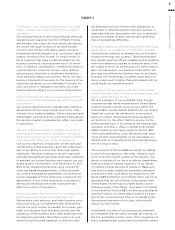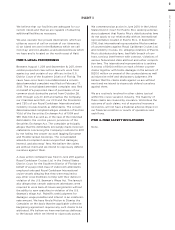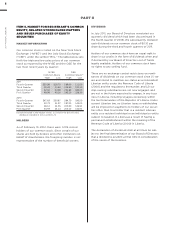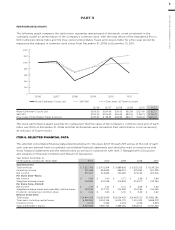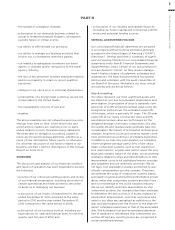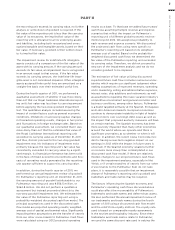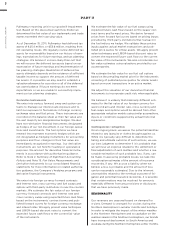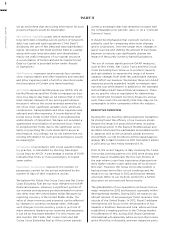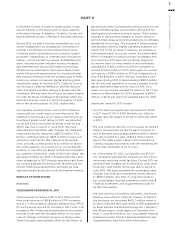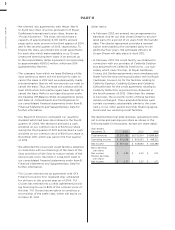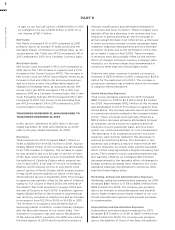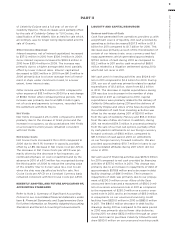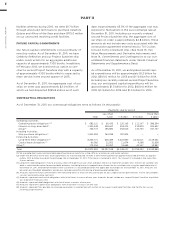Royal Caribbean Cruise Lines 2011 Annual Report Download - page 47
Download and view the complete annual report
Please find page 47 of the 2011 Royal Caribbean Cruise Lines annual report below. You can navigate through the pages in the report by either clicking on the pages listed below, or by using the keyword search tool below to find specific information within the annual report.
PART II
ROYAL CARIBBEAN CRUISES LTD. 43
FINANCIAL PRESENTATION
DESCRIPTION OF CERTAIN LINE ITEMS
Revenues
Our revenues are comprised of the following:
đƫƫPassenger ticket revenues, which consist of revenue
recognized from the sale of passenger tickets and the
sale of air transportation to and from our ships; and
đƫƫOnboard and other revenues, which consist primarily
of revenues from the sale of goods and/or services
onboard our ships not included in passenger ticket
prices, cancellation fees, sales of vacation protection
insurance, pre- and post-cruise tours, Pullmantur’s
land-based tours and hotel and air packages includ-
ing Pullmantur Air’s charter business to third parties.
Onboard and other revenues also include revenues we
receive from independent third party concessionaires
that pay us a percentage of their revenues in exchange
for the right to provide selected goods and/or services
onboard our ships.
Cruise Operating Expenses
Our cruise operating expenses are comprised of the
following:
đƫƫCommissions, transportation and other expenses,
which consist of those costs directly associated with
passenger ticket revenues, including travel agent
commissions, air and other transportation expenses,
port costs that vary with passenger headcounts and
related credit card fees;
đƫƫOnboard and other expenses, which consist of the
direct costs associated with onboard and other rev-
enues, including the costs of products sold onboard
our ships, vacation protection insurance premiums,
costs associated with pre- and post-cruise tours and
related credit card fees as well as the minimal costs
associated with concession revenues, as the costs
are mostly incurred by third-party concessionaires;
đƫƫPayroll and related expenses, which consist of costs
for shipboard personnel (costs associated with our
shoreside personnel are included in marketing, selling
and administrative expenses);
đƫƫFood expenses, which include food costs for both
guests and crew;
đƫƫFuel expenses, which include fuel and related delivery
and storage costs, including the financial impact of
fuel swap agreements; and
đƫƫOther operating expenses, which consist primarily
of operating costs such as repairs and maintenance,
port costs that do not vary with passenger head-
counts, vessel operating lease costs, costs associated
with Pullmantur’s land-based tours and Pullmantur
Air’s charter business to third parties, vessel related
insurance and entertainment.
We do not allocate payroll and related costs, food
costs, fuel costs or other operating costs to the expense
categories attributable to passenger ticket revenues or
onboard and other revenues since they are incurred
to provide the total cruise vacation experience.
SELECTED OPERATIONAL AND FINANCIAL METRICS
We utilize a variety of operational and financial metrics
which are defined below to evaluate our performance
and financial condition. As discussed in more detail
herein, certain of these metrics are non-GAAP financial
measures which we believe provide useful information
to investors as a supplement to our consolidated
financial statements, which are prepared and presented
in accordance with GAAP. The presentation of non-
GAAP financial information is not intended to be con-
sidered in isolation or as a substitute for, or superior
to, the financial information prepared and presented
in accordance with GAAP.
Available Passenger Cruise Days (“APCD”) is our
measurement of capacity and represents double
occupancy per cabin multiplied by the number of
cruise days for the period. We use this measure to
perform capacity and rate analysis to identify our
main non-capacity drivers that cause our cruise
revenue and expenses to vary.
Gross Cruise Costs represent the sum of total cruise
operating expenses plus marketing, selling and
administrative expenses.
Gross Yields represent total revenues per APCD.
Net Cruise Costs and Net Cruise Costs Excluding Fuel
represent Gross Cruise Costs excluding commissions,
transportation and other expenses and onboard and
other expenses and, in the case of Net Cruise Costs
Excluding Fuel, fuel (each of which is described above
under the Description of Certain Line Items heading).
In measuring our ability to control costs in a manner
that positively impacts net income, we believe changes
in Net Cruise Costs and Net Cruise Costs Excluding
Fuel to be the most relevant indicators of our perfor-
mance. A reconciliation of historical Gross Cruise Costs
to Net Cruise Costs and Net Cruise Costs Excluding
Fuel is provided below under Results of Operations.
We have not provided a quantitative reconciliation of
projected Gross Cruise Costs to projected Net Cruise
Costs and projected Net Cruise Costs Excluding Fuel
due to the significant uncertainty in projecting the costs
deducted to arrive at these measures. Accordingly,


